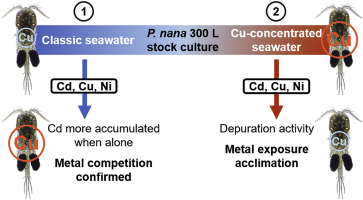当前位置:
X-MOL 学术
›
Chemosphere
›
论文详情
Our official English website, www.x-mol.net, welcomes your feedback! (Note: you will need to create a separate account there.)
Effects of different routes of exposure to metals on bioaccumulation and population growth of the cyclopoid copepod Paracyclopina nana.
Chemosphere ( IF 8.8 ) Pub Date : 2020-01-23 , DOI: 10.1016/j.chemosphere.2020.125926 Paul Dayras 1 , Capucine Bialais 1 , Baghdad Ouddane 2 , Jae-Seong Lee 3 , Sami Souissi 1
Chemosphere ( IF 8.8 ) Pub Date : 2020-01-23 , DOI: 10.1016/j.chemosphere.2020.125926 Paul Dayras 1 , Capucine Bialais 1 , Baghdad Ouddane 2 , Jae-Seong Lee 3 , Sami Souissi 1
Affiliation

|
We examined effects of the three metals cadmium (Cd), copper (Cu), and nickel (Ni) on two subpopulations of the cyclopoid copepod Paracyclopina nana. We sought to investigate the effects of metal exposure on population growth and structure of P. nana and to understand the parameters affecting the metal bioaccumulation in copepods. A first experiment tested the hypothesis of competition between these metals in a mixture using a P. nana mass culture in 10 L beakers with the sublethal concentrations (1/3 of LC50) as determined for E. affinis. A second experiment pursued the same with a P. nana population which was adapted to a higher Cu concentration for several generations (226.9 ± 15.9 μg g-1 dw Cu in copepods) and using the proper sublethal concentrations for P. nana. After 96 h of exposure, results from the first experiment showed a decreasing population growth and instead of an increasing metal accumulation in copepods. Cd also appeared to be more accumulated when it was alone, confirming the hypothesis of metal competition in mixture. Results from the second experiment revealed less marked effects. When metal concentrations increased in the treatment it decreased in copepods, indicating depuration activity in the population already adapted to metal exposure. This paper is the first one investigating the parameters affecting the bioaccumulation capacity of P. nana in response to metals. It offers a better understanding of copepod responses to metal contamination in a complex aquatic environment.
中文翻译:

不同的金属暴露途径对类脂足类pe足类对虾的生物积累和种群增长的影响。
我们检查了三种金属镉(Cd),铜(Cu)和镍(Ni)对摆线形pe足类Paracyclopina nana的两个亚群的影响。我们试图调查金属暴露对P. nana种群增长和结构的影响,并了解影响co足类动物中金属生物积累的参数。第一个实验测试了假单胞菌对亚致死浓度(LC50的半数致死)的致死浓度(LC50的1/3)在10 L烧杯中使用假单胞菌大规模培养物测试了混合物中这些金属之间竞争的假设。第二个实验使用的是P. nana种群,该种群适应了更高的铜浓度几代(for足类动物中226.9±15.9μgg-1 dw Cu),并使用了适当的亚致死浓度。暴露96小时后,第一个实验的结果表明种群减少,而population足类的金属积累却没有增加。单独存在时,Cd似乎也会积累更多,这证实了混合物中金属竞争的假设。第二个实验的结果显示效果较差。当处理中金属浓度增加时,co足类动物中的金属浓度降低,表明已经适应金属暴露的种群中的净化活动。本文是第一个研究影响P. nana对金属生物积累能力的参数的研究。它对复杂水生环境中environment足类对金属污染的响应提供了更好的理解。证实了混合物中金属竞争的假设。第二个实验的结果显示效果较差。当处理中金属浓度增加时,co足类动物中的金属浓度降低,表明已经适应金属暴露的种群中的净化活动。本文是第一个研究影响P. nana对金属生物积累能力的参数的研究。它对复杂水生环境中environment足类对金属污染的响应提供了更好的理解。证实了混合物中金属竞争的假设。第二个实验的结果显示效果较差。当处理中金属浓度增加时,co足类动物中的金属浓度降低,表明已经适应金属暴露的种群中的净化活动。本文是第一个研究影响P. nana对金属生物积累能力的参数的研究。它对复杂水生环境中environment足类对金属污染的响应提供了更好的理解。本文是第一个研究影响P. nana对金属的生物积累能力的参数的研究。它提供了对复杂水生环境中co足类动物对金属污染的响应的更好理解。本文是第一个研究影响P. nana对金属生物积累能力的参数的研究。它对复杂水生环境中environment足类对金属污染的响应提供了更好的理解。
更新日期:2020-01-23
中文翻译:

不同的金属暴露途径对类脂足类pe足类对虾的生物积累和种群增长的影响。
我们检查了三种金属镉(Cd),铜(Cu)和镍(Ni)对摆线形pe足类Paracyclopina nana的两个亚群的影响。我们试图调查金属暴露对P. nana种群增长和结构的影响,并了解影响co足类动物中金属生物积累的参数。第一个实验测试了假单胞菌对亚致死浓度(LC50的半数致死)的致死浓度(LC50的1/3)在10 L烧杯中使用假单胞菌大规模培养物测试了混合物中这些金属之间竞争的假设。第二个实验使用的是P. nana种群,该种群适应了更高的铜浓度几代(for足类动物中226.9±15.9μgg-1 dw Cu),并使用了适当的亚致死浓度。暴露96小时后,第一个实验的结果表明种群减少,而population足类的金属积累却没有增加。单独存在时,Cd似乎也会积累更多,这证实了混合物中金属竞争的假设。第二个实验的结果显示效果较差。当处理中金属浓度增加时,co足类动物中的金属浓度降低,表明已经适应金属暴露的种群中的净化活动。本文是第一个研究影响P. nana对金属生物积累能力的参数的研究。它对复杂水生环境中environment足类对金属污染的响应提供了更好的理解。证实了混合物中金属竞争的假设。第二个实验的结果显示效果较差。当处理中金属浓度增加时,co足类动物中的金属浓度降低,表明已经适应金属暴露的种群中的净化活动。本文是第一个研究影响P. nana对金属生物积累能力的参数的研究。它对复杂水生环境中environment足类对金属污染的响应提供了更好的理解。证实了混合物中金属竞争的假设。第二个实验的结果显示效果较差。当处理中金属浓度增加时,co足类动物中的金属浓度降低,表明已经适应金属暴露的种群中的净化活动。本文是第一个研究影响P. nana对金属生物积累能力的参数的研究。它对复杂水生环境中environment足类对金属污染的响应提供了更好的理解。本文是第一个研究影响P. nana对金属的生物积累能力的参数的研究。它提供了对复杂水生环境中co足类动物对金属污染的响应的更好理解。本文是第一个研究影响P. nana对金属生物积累能力的参数的研究。它对复杂水生环境中environment足类对金属污染的响应提供了更好的理解。


























 京公网安备 11010802027423号
京公网安备 11010802027423号